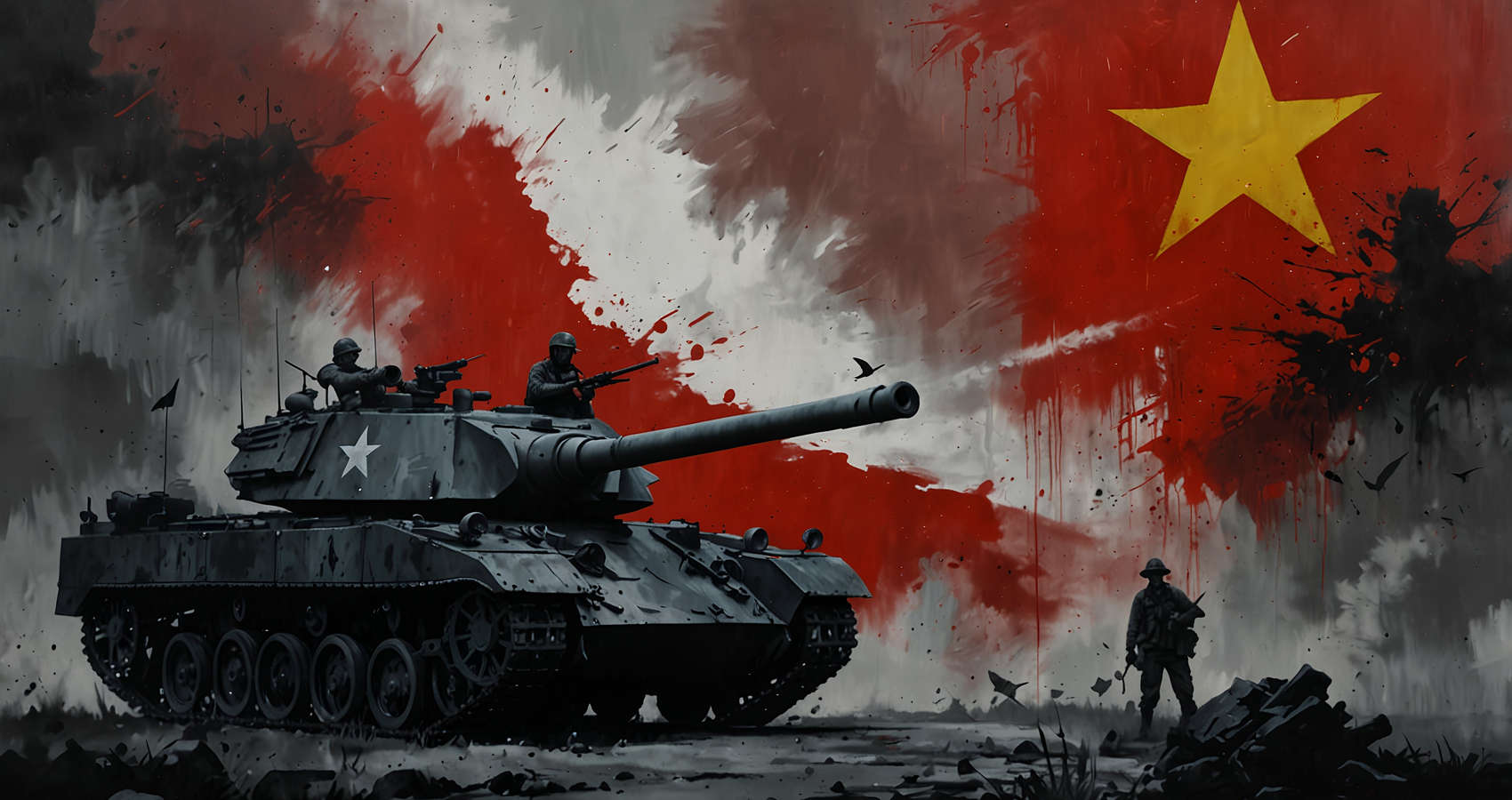May Girl
written by: Michael Dedrick
Sitting alone, half-drunk in front of a fireplace at the Vietnam Veterans Against the War regional headquarters in Seattle, I stared into the flames. It had been three years since my return from Vietnam. Usually, alcohol dulled my war memories. Not this time. In this moment they threatened to smother me with their intensity. Perhaps my reaction was triggered by the fire, but I suddenly, broke out sobbing, tears dripping down my face. I did not understand what was happening. Only later, as the images of that girl and her horrific death returned to me again and again, would I realize how much that day had affected me.
Drafted in March 1966, after boot camp, I flew to Fort Holabird, Baltimore, for Intelligence Analyst, and Interrogator schools, and later to Fort Bliss, El Paso Texas, for Vietnamese Language instruction. I knew I was headed to Vietnam. I arrived in Saigon at Company A, 519th Military Intelligence (MI) Battalion in November 1967, just in time to witness National Liberation Forces (NLF) attacking provincial and district capitals in Vietnam in what became known as the Tet Offensive.
In our neighborhood, Plantation Road, Cholon, we were roused early one morning by gunfire and explosions from hundreds of NLF soldiers who assaulted Ton Son Nhut Airfield, the huge Saigon airport a few kilometers north of us. They also attacked to the south, at the Phu To Hoa Racetrack in Cholon, a few hundred meters from our Combined Military Interrogation Center (CMIC). We could hear distant explosions and gunfire as fighting raged in the old Massiges French military cemetery next to Ton Son Nhut, with NLF and Army of the Republic of Vietnam (ARVN) countrymen engaged in a brutal fratricidal irony of the war, killing each other over the graves of French soldiers from the 19th Century colonial wars.
My fellow soldiers and I spoke Vietnamese and were friendly with the villagers. It was like a neighborhood, and children would call out in Vietnamese “Where are you going?” (di dau day) and “How are you?” (ban khoe khong), or “You numbah one GI.” This familiarity extended to the working girls from the bars who shouted lewd but friendly comments as we drove or walked by. I often talked with these women as I sat in front of a fan drinking the wretched local warm, but cheap, bier 33, cooled in a glass with ice chipped from a block.
As the Tet fighting along Plantation Road ebbed, we assembled a small convoy together to relieve the people at CMIC, but we had to take a back road through what was left of the neighborhood down the street from our compound because of roadblocks manned by jittery, trigger-happy ARVN soldiers. The damage looked like pictures I had seen of bombed-out European cities after WWII.
Hundreds of yards along Plantation Road were lined with burned and bombed-out buildings, rubble, and trash spilled into the streets. Dead bodies were scattered along the road, including several NLF fighters in black pajamas, their heat-swollen, putrid, and blackened corpses seemed to serve as mute backdrop for the still-smoldering ruins of the villages. We drove around the grotesque remains for three days before the bodies were finally picked up. I think the ARVN wanted to make an example of them. After the first day, I tried not to look anymore.
Bill Clower, one of our courier/drivers for the battalion, told us he saw dead civilians killed by airstrikes and gunship strafing being loaded into dump trucks for burial in mass graves, something that was, for a Buddhist society who revered their ancestry, a heartbreaking loss of connection for the families.
The night sky was often illuminated by huge aluminum canister magnesium flares, drifting by on their white parachutes and lighting up the neighborhood like it was on a stage. We often saw the C-47 “Spooky,” a converted cargo plane with miniguns, also called “Puff” or “Dragon” ship after the song Puff the Magic Dragon, in the distance, its red blinking light clearly visible in the black night. It sounded like a grinder as it spewed rounds down to the jungle, the tracers an avalanche of red rain. Then we watched the answering green tracer fire from NLF soldiers on the ground.
The night show on the roof was not without its dangers, with stray gunfire zipping past, a phfft sound that was too close for comfort, and bullets peppering the sides of our barracks. Along with red, green, and white tracers, and 50-caliber tracers the size of golf balls, drifting dangerously close and chasing us off the rooftop. We heard muted thunder when B-52 bombers dropped their loads of 250 and 500-pound bombs in the distance, when they dropped at night, flashes of orange and white explosions paraded along the horizon and the ground trembled underfoot. As a military intelligence unit, we knew when many of the attacks were expected, but none of us were ready for the intimacy and scale of the carnage that followed.
On the morning of May 7th, the fighting came to our door. I was on the roof of our barracks with some of my comrades and saw a company of ARVN infantry move up to the edge of the village, about a hundred meters away, apparently in response to some NLF infiltrators. They unloaded from deuce-and-a-half-ton trucks and slowly advanced to the perimeter of the village before halting. I assumed they called in air strike support because first helicopter Huey gunships started firing machine guns and rockets, then F-100 and F-4 fighter jets dropped napalm and white phosphorus. The jets were bright silver against the blue sky and as the napalm hit the village it exploded into orange flaming balls of fire as the canister crashed forward, thatched roofs and flimsy wooden walls of the houses were immediately swallowed in flames.
The flash of the heatwave nearly singed my face and I could smell the petroleum of the napalm even at a hundred meters. The phosphorus bombs, known as “willy peter,” exploded in white tendrils spraying everywhere. I imagined the people, now burning alive, and felt sick at what I was witnessing. Some propeller Thunderbolt planes showed up next and began dropping 250-pound bombs, the huge blasts and concussive shockwaves pushed forcefully against my body. As we ducked down, the plane dropped a 500-pound bomb which made an even more enormous explosion and shockwave. Seconds after this bomb exploded, shrapnel started flying and falling on the roof spraying us with chunks of hot metal, some softball size, ugly, black and brown, smoking, and acrid. Searing metal hit my steel helmet and flak jacket and burned my arms as I flattened myself on the concrete roof. The visual spectacle of the explosions and napalm turned into fear with the realization that I could be wounded, a fear that stayed with me whenever I scrambled into bunkers at the sound of incoming mortars, small arms fire, and rockets during later field deployments.
In a surreal scene, First Sergeant Maier was recording and narrating the attacks, with Wayne Goble, but when the attack turned more dangerous than expected, he ordered everyone off the roof, except for our M-60 machine gunner who had a sandbagged bunker in the corner.
“I’m hit, I’m hit,” Mark Wiseman, one of our editors at CMIC, yelled as we were scrambling off the roof. Fortunately, his injury was not serious. Yet, as we waited below, an injured soldier was carried by us on a poncho liner bleeding from a leg wound and moaning, pain contorting his face as the blood drenched his pants.
Later that day, after the strafing and bombing halted, the villagers brought some of their dead and wounded into our barracks. Even though they had been bombed and burned by American planes, these people came to us because they knew us and thought we could help. They also had no other place to go. About a dozen people came or were carried into the central open area of the barracks, bleeding, limping, crying, moaning, or already dead.
One young teenage girl, clothes and body shredded, was rolled into the area in an old wooden two-wheeled cart. She lay crumpled, intermittently screaming, and then passing out again. She had been hit by rocket shrapnel and had severe burns from napalm and phosphorus. It was miraculous that she was still alive.
Her parents tried to comfort her, murmuring softly, and stroking her face. On lockdown with nowhere to go, my comrades and I were forced to stay and listen to her tortured screams, prisoners to her vocal agony.
“Don’t we have any fucking morphine for her?” I yelled, in a panic to do something. I ran over to our medic.
“I don’t have any,” he said, “I’m just doing the best I can to help the rest of the wounded.”
One of my fellow interrogators, Joe, a guy I had known since our stateside training, came up to me and said, “I don’t feel sorry for her.” I was so shocked by his denial of this young girl’s agony that I said nothing and turned away feeling overwhelmed and numb. Her piercing cries were excruciating. I was also angry at what my fellow soldiers had done to this girl but realized later that I might have done the same in their shoes.
I wondered how she managed to scream so loudly considering the severity of her wounds. After a while, watching her suffer became unbearable and I hoped she would die and put us all out of our misery. I do not remember much of what she screamed except “du ma me” which means motherfucker in Vietnamese, a phrase she probably picked up from GIs, as it was not something a young Vietnamese girl would normally say. I was shocked at her language, but I understood she was merely using the worst words she could find to express her agony. It took a long time for her to die, and although it was only an hour or so, her ear-splitting cries seemed to go on forever. By the time the girl finally stopped screaming and died, several other people had also died, some so badly chewed up by shrapnel they were barely recognizable. There now ghostly grey bodies were deafening in their silence.
When the fighting slowed down, an army ambulance, olive drab with a red cross, showed up for the dead and wounded. As I stepped forward and grabbed the handle of a stretcher, some of the girl’s blood smeared my arm, surprising me with its warmth. I bumped into another interrogator who had also stepped forward to help. When I looked into his face, I saw some of the same shock, anger, and sadness I was feeling. Although I had six months or so left in Vietnam, and more experiences with POWs that would mark me, that girl’s searing, horrific death, bound me in memory to her in a way I never could have imagined.
After a few days we were relieved from lockdown and ventured onto Plantation Road, seeing the carnage for the first time. It was difficult to see the annihilation of neighborhoods and not question the necessity of the unrestrained firepower that killed civilians. For us, the warfare was frightening and shocking, but for the civilians of Cholon, the destruction was a reminder of how ruthlessly the US fought the war. Designated as a free-fire zone meant no restraints were put on firepower. People were given scant notice to leave, and this casual indifference and brutality left thousands of civilians dead and tens of thousands homeless. Many victims had been refugees from failed pacification programs throughout the countryside.
For two weeks after the attack, I scoured our Intelligence Situation Reports log from Military Assistance Command Vietnam, which recorded combat actions—but found no record. It was as if the village destruction and the other extensive firefights and bombings along Plantation Road had never happened. By the time the Tet and May attacks ran their course, 8,000 civilians were declared dead citywide, most were from Cholon. Another 270,000 people were homeless, added to the 62,000 refugees from the Tet attacks.
Fifty years later, I boarded a plane to Las Vegas to attend a 525th Reunion. I was looking forward to meeting up with the soldiers who served with me during the May attack. After getting checked in, I made my way down to the reception area for the social hour and met Wayne, the French Language interrogator at CMIC who had recorded the attack with the First Sergeant. He was standing with Bill Clower and several other soldiers. Wayne brought up the attack on the village and the estimated two hundred casualties, “innocents,” as he called them.
“You remember that girl who was screaming?” Larry, another soldier, blurted out. We all nodded, momentarily launched back to that horrific time.
It was vindicating to know that I was not the only one who had been so affected by this young girl’s suffering. When I exchanged emails with Joe, he claimed to have no memory of her at all. I wondered if this was a type of defense mechanism, a way to shut out the dangerous and painful memories.
I envied his ability to forget. For me, the images of that day and others became a slideshow of trauma that vividly played in the background of my consciousness for years, only abating in 2006 with the suggestion of a Veteran’s Administration (VA) counselor that I write about the experience. In a deeply ironic VA group therapy session with combat Vietnam veterans, we were introduced to mindfulness and meditation exercises using handouts modeled from the teaching of Thich Nhat Hanh, a pacifist, Buddhist, and Vietnamese monk. Though I will never be able to completely erase the horror of that young girl’s screams, the hundreds of innocents who died that day, or the fear I felt throughout my remaining months in Vietnam, these exercises have helped to mitigate the debilitating effects of my post-traumatic stress. They have helped me survive when so many others did not.



